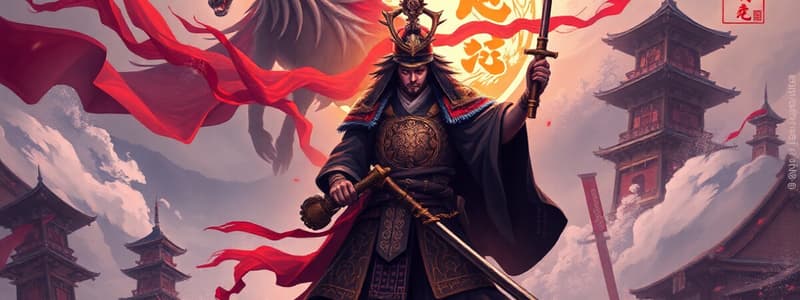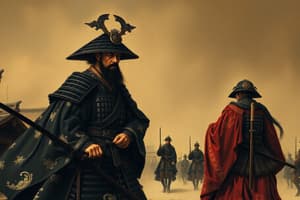Podcast
Questions and Answers
How did land ownership primarily influence social classes in feudal Japan?
How did land ownership primarily influence social classes in feudal Japan?
- It facilitated trade relationships with neighboring countries.
- It established a hereditary military dictatorship and defined social standing. (correct)
- It dictated political representation in the Imperial Court.
- It determined access to religious institutions.
What was the significance of the term 'tent government' (bakufu) in the context of the shogunate?
What was the significance of the term 'tent government' (bakufu) in the context of the shogunate?
- It symbolized the shogun's commitment to pacifism and diplomacy.
- It indicated the shogun's direct involvement in warfare and the provisional nature of their rule. (correct)
- It highlighted the shogun's reliance on agricultural policies for governance.
- It reflected the shogun's dedication to urban development and infrastructure projects.
What was the relationship between the Shogun and the Daimyo in feudal Japan?
What was the relationship between the Shogun and the Daimyo in feudal Japan?
- The Shogun reported to the Daimyo, who held ultimate authority over military matters.
- The Daimyo reported to the Shogun in return for land and military support. (correct)
- The Shogun and Daimyo were equals and represented the Emperor.
- The Daimyo were beneath the Shogun, who paid them in rice and privileges.
How does the content describe the transition of power from the Imperial Court to the Shogun?
How does the content describe the transition of power from the Imperial Court to the Shogun?
What distinguished Japan’s feudal social structure from other cultures, such as European medieval feudalism?
What distinguished Japan’s feudal social structure from other cultures, such as European medieval feudalism?
Which of the following best describes the relationship between the shogun and the daimyo in feudal Japan?
Which of the following best describes the relationship between the shogun and the daimyo in feudal Japan?
How did the Japanese feudal system differ from the European feudal system regarding the peasant class?
How did the Japanese feudal system differ from the European feudal system regarding the peasant class?
Why were merchants placed at the bottom of the four classes in feudal Japan?
Why were merchants placed at the bottom of the four classes in feudal Japan?
Which of the following activities would cause someone to be classified as burakumin in feudal Japan?
Which of the following activities would cause someone to be classified as burakumin in feudal Japan?
What distinguished the 'untouchables' from the burakumin in the Japanese feudal social structure?
What distinguished the 'untouchables' from the burakumin in the Japanese feudal social structure?
Flashcards
Japanese Feudal System
Japanese Feudal System
A hereditary military dictatorship and caste system in Japan from 1185-1603.
Daimyo
Daimyo
Regional feudal lords who received land from the shogun in exchange for homage and military support.
Samurai
Samurai
Warriors employed by the daimyo to protect their land, paid in rice and privileges.
Shogun
Shogun
Signup and view all the flashcards
Tent Government (Bakufu)
Tent Government (Bakufu)
Signup and view all the flashcards
Peasants (Farmers)
Peasants (Farmers)
Signup and view all the flashcards
Artisans
Artisans
Signup and view all the flashcards
Merchants
Merchants
Signup and view all the flashcards
Study Notes
- The shoguns rose to power after the fall of the Imperial Court in 1185.
- Shoguns established a feudal hereditary military dictatorship, creating a new caste system.
- This system dictated Japanese social classes for four centuries.
- Japanese feudalism was governmental rule by land ownership during Japan's Middle Ages (1185-1603).
- Land was considered sacred, and connection to it determined social classes.
- The rise of feudalism began when the title of shogun was bestowed on the top military leader.
- The shogun gave land to the daimyo, regional feudal lords.
- The daimyo were required to pay homage and provide military support to the shogun.
- The daimyo employed samurai to protect their land and paid them in rice and other privileges.
- Beneath the samurai were farmers, artisans, and merchants.
- Excluded groups existed at the bottom of Japan's caste system, some not recognized as citizens.
- Japanese feudal society revered land and people's connection to it.
- This placed peasants in higher social classes compared to some other cultures.
Aristocracy
- Land ownership defined the aristocratic class.
- The emperor and the court nobles were at the top, but their political influence dwindled when the title of shogun was bestowed to Minamoto Yoritomo in 1185.
- The Imperial Court became more distant from rural territories and ordinary people as cities emerged.
- The monarchy had little to offer Japan with the shift toward feudalism under military leaders.
- Noble land became concentrated in urban areas.
- The shogun ruled farmland.
- The shogun was the military leader in charge in medieval Japan, comparable to a prime minister.
- The shogun headed a military family and constructed a government based on military rule through tent governments.
- The term "tent government" came from "bakufu," referring to the shogun's tent housing.
- The tent represented the shogun's active engagement and the temporary nature of the position.
- Shoguns wielded power through the daimyo.
- Without the daimyo's support, a shogun could be deposed.
- The daimyo received land from the shogun and paid with military service.
- Daimyo employed samurai and peasants.
- Daimyo were part of the warrior class alongside the samurai, but their status was determined by land ownership.
The Four Classes
- Outside the aristocracy were four classes of citizens who did not own land.
- The samurai were at the top of these four classes.
- The samurai served regional daimyos, protecting their land.
- Unlike medieval knights, samurai did not own land.
- Samurai were paid in rice and social status.
- Samurai were well-respected and held power in their communities.
- The majority of the population were peasants, or farmers.
- Peasants belonged to the upper echelons, unlike in Europe.
- Japan recognized the importance of food production.
- Farmers ensured everyone had enough to eat.
- Direct ties to land were revered.
- Peasants bore many tax burdens.
- Artisans ranked below peasants despite their education and training.
- Japanese society valued this class.
- Artisans made weapons for samurai and clothes for everyone.
- Artisans built temples and artwork.
- The lack of connection to land placed them lower on the social ladder.
- Feudalism employed segregation, and artisans lived in separate areas.
- Merchants were at the bottom of Japan's caste system.
- Japan viewed merchants as parasites benefiting from the work of others, without skills.
- This class consisted of shopkeepers, traveling traders, and professions in business.
- Merchants lived in separate neighborhoods.
- Higher classes were forbidden from socializing with them, except for business.
The Untouchables
- Below the four classes were the burakumin.
- Japanese feudal society considered their occupations unclean.
- Burakumin occupations: actors, butchers, entertainers, geisha, and leather tanners.
- Actors and entertainers were believed to threaten the minds of people.
- Occupations like slaughterhouse work were physically unclean.
- Burakumin were further removed from society.
- Below the burakumin were the untouchables.
- These were minority ethnic groups usually excluded from the class system.
- They faced heavy discrimination.
- Japan was and is a racially homogeneous nation.
- It was difficult for minority ethnic groups to find their place.
Studying That Suits You
Use AI to generate personalized quizzes and flashcards to suit your learning preferences.




